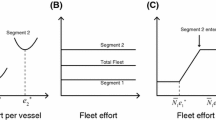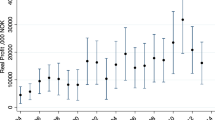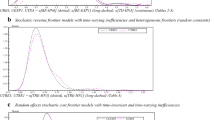Abstract
With a thin economic component, most bio-economic models of fisheries failto assess the effects of the regulation systems on firms. In order to analysethe short term consequences of different management schemes, a simulationmodel is applied to the French driftnet albacore fleet: licence allocation withdriftnet regulation, individual quotas, and individual transferable quotaswithout any input control. Vessel technology is estimated by using the datacollected, and groups of vessels are distinguished according to criteria ofperformance. We present the adjustment within firms and between groupsunder different scenarios (limited entry with and without driftnetregulation, individual quotas and individual transferable quotas allocation),and we compare their results in terms of quasi-rent value and otherindicators such as hake harvests or dolphin by-catches.
Similar content being viewed by others
References
Anon. (1990), Interaction de différents engins de pêche de la pêcherie de surface de germon de l'atlantique Nord-Est. rapport IFREMER/IEO. Réf. CEE 2018 DB/vt 18.7. 57 p.
Anon. (1998), Report of the Working Group on the Assessment of Southern Shelf Demersal Stocks. ICES CM 1999/ACFM: 4.
Antoine, L., M. Goujon and G. Massart (1997), ‘Captures accidentelles de dauphins dans les filets dérivants à thon en Atlantique Nord Est'. Conseil International pour l'Exploration des Mers. M 1997/Q: 10.
Antonie, L., O. Guyader and M. Goujon (1998), ‘Un changement de technique de pêche est-il compatible avec une pêche responsable? L'exemple de la pêche au germon (Thunnus alalunga) au filet dérivant en Atlantique Nord', ICCAT Tuna Symposium. ICCAT collective Volume of Scientific Papers 50(2), 651–660.
Anderson, L. G. (1994), ‘An Economic Analysis of Highgrading in ITQ Fisheries Regulation Programmes', Marine Resource Economics 9, 209–226.
Arnason, R. (1993), ‘The Icelandic Individual Transferable Quota System: A Descriptive Account', Marine Resource Economics 8, 201–218.
Arnason, R. (1996), ‘Property Rights as an Organizational Framework in Fisheries: The Case of Six Fishing Nations', in B. L. Crowley, ed., Taking Ownershp: Property Rights in Fishery Management on the Atlantic Coast, 99–144. Canada: Atlantic Institute for Market Studies.
Boyce, J. R. (1992), ‘Individual Transferable Quotas and Production Externalities in a Fishery', Natural Resource Modelling 6(4), 385–407.
Casey, K. E., C. M. Dewees et al. (1995), ‘The effects of individual vessel quotas in the British Columbia halibut fishery', Marine Resource Economics 10(3), 211–230.
Christy, F. T. Jr. (1973), Fishermen Quotas: A Tentative Suggestion for Domestic Management. Law of the Sea Institute University of Rhode Island, Occasional Paper 19, Kingston, Rhode Island.
Clark, C. W. (1990), Mathematical Bioeconomics. The Optimal Management of Renewable Resources, 2nd edition. New York: John Wiley & Sons.
Copes, P. (1986), ‘A Critical Review of the Individual Quota as a Device in Fisheries Management', Land Economics 62(3), 278–291.
Copes, P. (1997), Alternatives in fisheries management, in UBO-ENSAR(Ed) proceedings of the IXth annual conference of the European Association of Fisheries Economists, 10-35. Quimper, 28-30 April.
Crothers, S. (1986), ‘Individual Transferable Quotas: the New Zealand experience', Fisheries 13(1), 10–15.
Cunningham, S. (1994), ‘Fishermen's Incomes and Fisheries Management', Marine Resource Economics 9(3), 241–252.
Davidse, W. E. (1997), Property rights in fishing; effects on the industry and effectiveness for fishery management policy. LEI-DLO.
Dupont, D. P. and S. A. Phipps (1991a), ‘Individual Vessel Quotas and Income Effects', Canadian Journal of Regional Science 14(2), 157–180.
Dupont, D. P. and S. A. Phipps (1991b), ‘Distributional Consequences of Fisheries Regulations', Canadian Journal of Economics 24(1), 206–220.
Eythorsson, E. (1996), ‘Theory and Practice of ITQs in Iceland: Privatization of Common Fishing Rights', Marine Policy 20(3), 269–281.
Findlay, M. and A. E. Searle (1998), ‘The North East Atlantic Albacore Fishery: A Cornish Crisis of Confidence', Marine Policy 22(2), 95–108.
Carcienda, F. (1996), Analisis economico de la pesqueria del stock norte de atun blanco con mencion especial al caso vasco. Tesis Doctoral. Universidas de Deusto. Facildad de CC.EE. y Empresariales (ESTE). San Sebastian.
Garza-Gil, D. G. (1998), ‘ITQ systems in Multifleet Fisheries: An Application for Ibero-atlantic Hake', Environmental and Resource Economics 11, 79–92.
Goujon, M. (1996), Captures accidentelles du filet maillant dérivant et dynamique des populations de dauphins au large due Golfe de Gascogne. Thèse de doctorat, Ecole Nationale Supérieure Agronomique de Rennes, France.
Griffin, W. L., K. Roberts, A. B. Lamberte, J.M. Ward and H. M. Hendrickson (1992), Consideration for the Potential use of Individual Transferable Quotas in the Gulf of Mexico Shrimp Fishery 3, 125. National Marine Fisheries Service, Silver Sprind. MD.
Guyader, O. (1998), ‘Transition from Open Access to Regulatory System with Subsidies: The Case of the French Driftnet Fleet', Proceedings of the first Concerted Action Workshop on Economics and the Common Fishery Policy, UK, 28-30 October. CEMARE Miscellaneous Publiation no 44, 109–124.
Guyader, O. (2000), Evaluation économique de la régulation des pêches: le cas du stock de germon de l'Atlantique Nord-Est, 366. L'Harmattan, Paris.
Guyader, O. and O. Thebaud (2000), ‘Distributional Issues in the Operation of Rights-Based Fisheries Management Systems', Marine Policy 25, 103–112.
Guyader, O., F. Daurès and F. Fifas (2000), A bioeconomic analysis of the impact of decommissioning schemes: application to a limited entry scallop French fishery, in proceedings of the IIFET biannual Conference, Corvallis, Oregon, U.S.A., July.
Hahn, R. W. (1984), ‘Market Power and Transferable Property Rights', Quarterly Journal of Economics, 753–765.
Hannesson, R. (1993), ‘Fishing Capacity and Harvest Rules', Marine Resource Economics 8, 133–143.
Hatcher, A. and K. Robinson ed. (1998), Overcapacity, Overcapitalisation and Subsidies in European Fisheries. Proceedings of the first Concerted Action workshop on Economics and the Common Fisheries Policy: UK, 28-30 October. CEMARE Miscellaneous Publication no. 44.
Hatcher, A. and K. Robinson ed. (1999), The definition and Allocation of Use rights in European Fisheries. Proceedings of the second Concerted Action workshop on Economics and the Common Fisheries Policy: UK, 5-7 May. CEMARE Miscellaneous Publication no. 46.
Hoefnagel, E. and W. Smit (1997), ‘Co-Management and Property Rights in the Netherlands', in G. Petursdottir, ed., Property Rights in the Fishing Industry, 11–24. Fisheries Research Institute, University of Iceland Press, Iceland.
Holden, M. (1995), The Common Fisheries Policy: Origin. Evaluation and Future. Update by D. Garrod, Fishing News Books, Oxford.
Huppert, D. D., L. Anderson and R. Harding (1992), Consideration of Individual Fishing Quotas in the North Pacific Groundfish Trawl Fishery 2, 121. National Marine Fisheries Service, Silver Spring MD.
ICCAT (1996), Collective volume of scientific papers, report of the final meeting of the ICCAT albacore research programme XLIII, 395.
ICCAT (1998), Statistical Bulletin of the International Commission for the Conservation of Atlantic Tunas. Madrid 1997, 28, 213.
Lindner, R. K., H. F. Campbell and G. F. Bevin (1992), ‘Rent Generation During the Transition to a Managed Fishery: the Case of the New Zealand ITQ System', Marine Resource Economics 7, 229–248.
Macinko, S. (1993), ‘Public or private? United States commercial fisheries management and the public trust doctrine, reciprocal challenges', Natural Resource Journal 33, 919–955.
Matulich, S. C., R. C. Mittelhammer et al. (1996), ‘Toward a more complete model of individual transferable fishing quotas: implications of incorporating the process sector', Journal of Environmental Economics and Management 31, 112–128.
McCay, B. J. and C. F. Creed et al. (1995), ‘Individual transferable quotas (ITQs) in Canadian and US fisheries', Ocean and Coastal Management 28, 85–115.
Moloney, D. G. and P. H. Pearse (1979), ‘Quantitative Rights an Instrument for Regulating Commercial Fisheries', J. Fish. Res. Board Can. 36, 859–866.
OCDE (1993), L'utilisation des contingents individuels dans la pêche. OCDE publications, Paris.
OCDE (1997), Towards sustainable fisheries: economic aspects of the management of living marine resources. Paris, OCDE publications, Paris.
Palsson, G. and G. E. Petursdottir (1997), Social implications of quota systems in fisheries. Copenhague, TemaNord.
Runolfsson, B. (1999), ‘ITSQs in Icelandic fisheries: a rights-based approach to fisheries management', in A. Hatcher and K. Robinson, ed., The definition and Allocation of Use rights in European Fisheries. Proceedings of the second Concerted Action workshop on Economics and the Common Fisheries Policy: UK, 5-7 May. CEMARE Miscellaneous Publication no. 46.
Santiago, J. et al. (1996), Efectos de la introduction del arrastre por la flota vasca de bajura en las pesquerias de anchoa y atun blanco, Informes tecnicos No. 73. Gobierno Vasco. Departamento de Industria. Agricultura y Pesca. 139 p.
Scott, A. (1988), ‘Development of Property in the Fishery', Marine Resource Economics 5, 289–311.
Squires, D., M. Alauddin and J. Kirkley (1994), ‘Individual Transferable Quota Markets and Investment Decisions in the Fixed Gear Sablefish Industry', Journal of Environmental Economics and Management 27, 185–204.
Squires, D., J. Kirkley and C. A. Tisdell (1995a), ‘Individual Transferable Quotas as a Fisheries Management Tool', Reviews in Fisheries Science 3(2), 141–169.
Squires, D. and J. Kirkley (1995b), ‘Resource rents from single and multi-species individual transferable quota programmes', ICES J. mar. Sci. 52, 153–164.
Stigler, G. J. (1966), The Theory of Price. Third Ed. New York: Macmillan.
Stephenson, R. L., D. E. Lane, D. G. Aldous and R. Nowak (1993), ‘Management of the 4WX Atlantic Herring (Clupea Harengus) Fishery: An Evaluation of Recents Events', Canadian Journal of Fisheries and Aquatic Sciences 50, 2742–2757.
STECF (1993), 24th report of the Scientific and Technical Committee for fisheries. Commission of the European Communities, Commission Staff working paper, Brussels, 15-17 November.
Sutinen, J. G. (1979), ‘Fishermen Remuneration Systems and Implications for Fisheries Development', Scottish Journal of Pol. Econ. (June) 26(2), 147–162.
Sutinen, J. G., P. Mace, J. Kirkley, W. DuPaul and S. Edwards (1992), Consideration for the potential use of Individual Transferable Quotas in the Atlantic Sea Scallops Fishery 5, 131. National Marine Fisheries Service, Silver Sprind. MD.
Terry, J. M. (1993), Quotas individuels transférables puor la pêche à la morue charbonnière et au flétan avec des engins fixes au large de l'Alaska. L'utlisation des contingents dans la gestion des pêches, OCDE, Paris 103–130.
Townsend, R. E. (1990), ‘Entry Restrictions in the Fishery: A Survey of the Evidence', Land Economics 66(4), 359–378.
Wang, S. (1995), ‘The Surf Clam ITQ Management: An Evaluation', Marine Resource Economics 10, 93–98.
Vestergaard, N. (1996), ‘Discard Behaviour. Highgrading and Regulation: The Case of the Greenland Shrimp Fishery', Marine Resource Economics 11, 247–266.
Wenninger, Q. R. and R. E. Just (1997), ‘An Analysis of the Transition from Limited Entry to Transferable Quota: Non Marshalian Principles for Fisheries Management', Natural Resource Modelling 10(1), 53–83.
Wilen, J. E. (1988), ‘Limited Entry Licencing: A Retrospective Assessment’, Marine Resource Economics 5, 313–324.
Author information
Authors and Affiliations
Rights and permissions
About this article
Cite this article
Guyader, O. Simulating the Effect of Regulatory Systems in a Fishery, An Application to the French Driftnet Albacore Fleet. Environmental and Resource Economics 23, 1–28 (2002). https://doi.org/10.1023/A:1020273001099
Issue Date:
DOI: https://doi.org/10.1023/A:1020273001099




